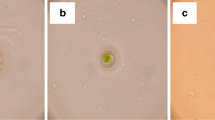Abstract
Rheological properties of Chlorella pyrenoidosa culture grown heterotrophically in a 14 L fermentor were investigated. It was found that the fluid viscosity was rather low and remained almost unchanged during the cultivation, implying that no (or very few) viscous substances were excreted into the medium. Investigation of the condensed suspension of C. pyrenoidosa showed that for biomass concentration under 150 g.L−1, the suspension of C. pyrenoidosa exhibited Newtonian behavior, and the fluid viscosity was rather low (about 40 mPa·s) and increased very slowly with the increase in cell concentration. With further increase in biomass concentration however, the fluid rheological behavior changed to non-Newtonian, and the fluid viscosity increased rapidly with the increase in cell concentration. From the viewpoint of rheology, C. pyrenoidosa is an excellent organism for high-cell-density culture, and there will be no rheological problems at cell densities under 150 g.L−1.




Similar content being viewed by others
References
Basu HN, Del Vecchio AJ, Flider F et al (2001) Nutritional and potential disease prevention properties of carotenoids. J Am Oil Chem Soc 78:665–675
Chen F (1996) High cell density culture of microalgae in heterotrophic growth. Trends Biotechnol 14:421–426
Chen F, Johns MR (1995) A strategy for high cell density culture of heterotrophic micoalgae with inhibitory substrates. J Appl Phycol 7:43–46
Chen F, Zhang YM, Guo SY (1996) Growth and phycocyanin formation of Spirulina platensis in photoheterotrophic culture. Biotechnol Lett 18:603–608
Doran PM (1995) Bioprocess Engineering Principles. Academic Press, London
Fernades HL, Lupi F, Tomé MM, Sa-Correia I, Novais JM (1991) Rheological behavior of the culture medium during growth of the microalga Botryococcus braunii. Bioresource Technol 38:133–136
Geresh S, Adin I, Yarmolinsky E, Karpasas M (2002) Characterization of the extracellular polysaccharide of Porphyridium sp.: molecular determination and rheological properties. Carbohyd Polym 50:183–189
Grima EM, Belarbi EH, Fernandez FGA, Medina AR, Chisti Y (2003) Recovery of microalgal biomass and metabolites: process options and economics. Biotechnol Adv 20:491–515
Lapasin R, Pricl S, Bertocchi C, Navarini L, Cearo A, De Philippis R (1992) Rheology of culture broths and exopolysaccharide of Cyanospira capsulate at different stages of growth. Carbohyd Polym 17:1–10
Mancini M, Moresi M (2000) Rheological behaviour of baker’s yeast suspensions. J Food Eng 44:225–231
Miao XL, Wu QY (2004) High yield bio-oil production from fast pyrolysis by metabolic controlling of Chlorella protothecoides. J Biotechnol 110:85–93
Olaizola M (2003) Commercial development of micro algal biotechnology: from the test tube to the marketplace. Biomol Eng 20:459–466
Reuss M, Debus D, Zoll G (1982) Rheological properties of fermentation fluids. Chem Eng 381:233–236
Scragg AH, Morrison J, Shales SW (2003) The use of a fuel containing Chlorella vulgaris in a diesel engine. Enzyme Microb Technol 33:884–889
Shi XM, Chen F, Yuan JP, Chen H (1997) Heterotrophic production of lutein by selected Chlorella strains. J Appl Phycol 9:445–450
Shi XM, Jiang Y, Chen F (2002) High-yield production of lutein by the green microalga Chlorella protothecoides in heterotrophic fed-batch culture. Biotechnol Prog 18:723–727
Tsukada O, Kawahara T (1997) Mass culture of chlorella in Asian countries. In: Mitsui A, Miyachi S, San-pietro A, Tamija H (ed) Biological solar energy conversion. Academic Press, New York, p 363
Wu ZY, Shi XM (2007) Optimization for high-density cultivation of heterotrophic Chlorella based on a hybrid neural network model. Lett Appl Microbiol 44:13–18
Acknowledgements
This work was supported by Ministry of Science and Technology of the People’s Republic of China (863 Project No. 2006AA02Z226).
Author information
Authors and Affiliations
Corresponding author
Rights and permissions
About this article
Cite this article
Wu, Zy., Shi, Xm. Rheological properties of Chlorella pyrenoidosa culture grown heterotrophically in a fermentor. J Appl Phycol 20, 279–282 (2008). https://doi.org/10.1007/s10811-007-9244-x
Received:
Revised:
Accepted:
Published:
Issue Date:
DOI: https://doi.org/10.1007/s10811-007-9244-x




